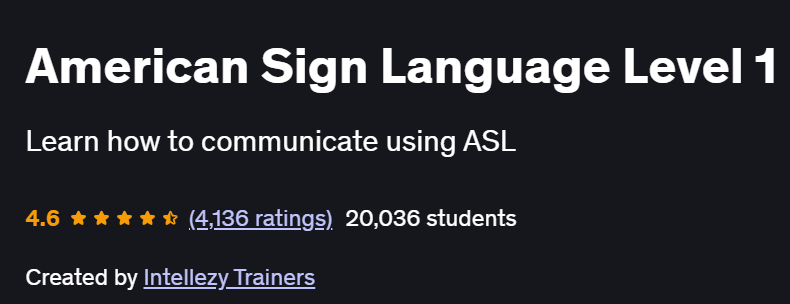What will you in American Sign Language Level 1 Course
Recognize and produce the ASL alphabet (fingerspelling) fluently
Master common greetings, introductions, and everyday phrases in ASL
Understand basic ASL grammar, facial expressions, and non-manual signals
Build vocabulary for family, numbers, colors, and classroom interactions
Develop receptive skills through watching and interpreting simple signed conversations
Program Overview
ASL Fundamentals & Fingerspelling
⏳ 45 minutes
Learning the 26-letter ASL alphabet and practice drills
Fingerpelling names, simple words, and spelling strategies
Greetings, Introductions & Politeness
⏳ 30 minutes
Common signs for “hello,” “please,” “thank you,” and “nice to meet you”
Introducing yourself and asking “What’s your name?”
Basic Grammar & Non-Manual Markers
⏳ 40 minutes
Understanding subject–verb–object order and topic-comment structure
Using facial expressions, head nods, and body shifts to convey meaning
Everyday Vocabulary: Family, Numbers & Colors
⏳ 50 minutes
Signs for family members, numbers 1–20, and primary colors
Combining vocabulary to describe family size and favorite colors
Simple Conversations & Practice
⏳ 55 minutes
Watching and interpreting short signed dialogues
Role-play exercises: ordering food, asking for directions, classroom phrases
Get certificate
Job Outlook
ASL skills open doors in education, interpreting, and social services
Opportunities as a sign language interpreter, educational assistant, or social worker
Valuable for teaching ASL, working with deaf or hard-of-hearing communities, and accessibility roles
Foundation for advanced ASL certification (NIC, BEI) and professional interpreting
Explore More Learning Paths
Enhance your language and communication skills with these related courses and resources. From American English pronunciation to expanding your ASL vocabulary, these learning paths will help you communicate more effectively and confidently.
Related Courses
Tricky American English Pronunciation
Master common pronunciation challenges in American English to improve clarity and fluency.The Pronunciation of American English Specialization
Build a strong foundation in American English pronunciation, stress, and intonation for effective communication.ASL: First 500 Basic Signs – American Sign Language
Expand your ASL vocabulary with the first 500 essential signs, enhancing your ability to communicate in American Sign Language.
Related Reading
What Is Human Resource Management
Understand how effective communication skills, including sign language proficiency, can support workplace interactions and inclusivity.
Specification: American Sign Language Level 1 Course
|
FAQs
- No, this course is designed for complete beginners.
- It starts with the alphabet and simple greetings.
- Grammar basics are introduced gradually.
- Visual demonstrations make signs easy to follow.
- No language-learning background is required.
- Teaches greetings, introductions, and everyday phrases.
- Covers vocabulary for family, numbers, and colors.
- Includes role-play scenarios like ordering food or asking directions.
- Receptive skills improve through video dialogues.
- Builds confidence to interact with deaf or hard-of-hearing individuals.
- Yes, lessons are beginner-friendly for all ages.
- Families can practice fingerspelling names and greetings together.
- Visual repetition supports younger learners.
- Group learning helps reinforce memory.
- It’s ideal for families wanting to communicate inclusively.
- Helpful in education and teaching support roles.
- Valuable in healthcare and social services.
- Opens pathways to interpreting with advanced training.
- Supports careers in accessibility and advocacy.
- Enhances inclusivity in customer-facing jobs.
- Practice with deaf community events or online groups.
- Move on to ASL Level 2 or interpreting-focused courses.
- Watch sign language videos and practice receptive skills.
- Use signing apps or flashcards to reinforce vocabulary.
- Consider certification (NIC, BEI) for professional pathways.





